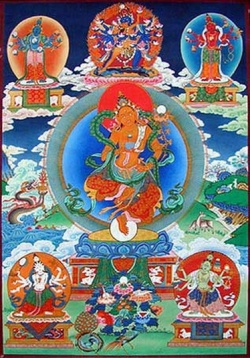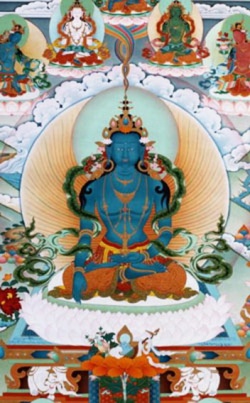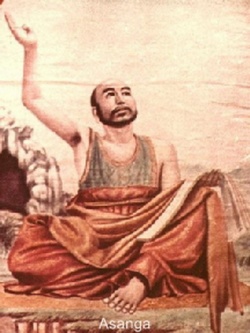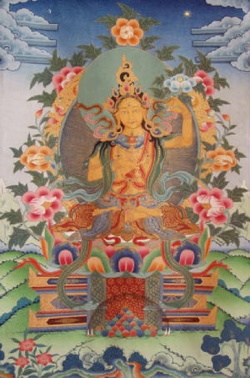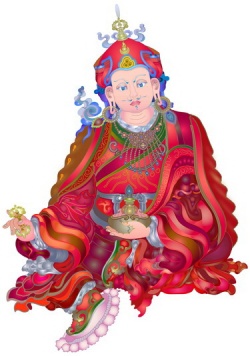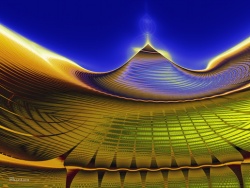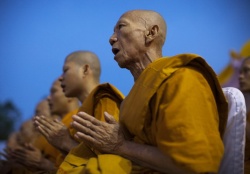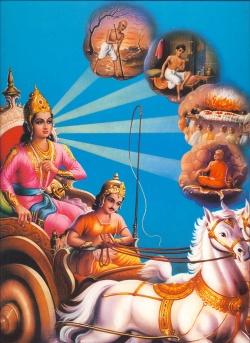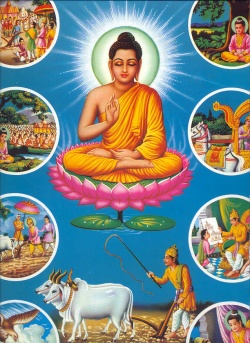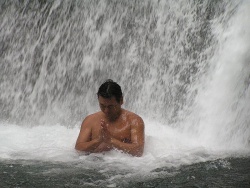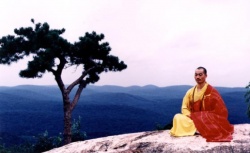Dharma transmission
In Zen-Buddhism, Dharma transmission is a custom in which a person is established as a "successor in an unbroken lineage of teachers and disciples, a spiritual 'bloodline' (kechimyaku) theoretically traced back to the Buddha himself." The dharma lineage reflects the importance of family-structures in ancient China, and forms a symbolic and ritual recreation of this system for the monastical "family".
In Rinzai-Zen, inka shōmei is ideally "the formal recognition of Zen's deepest realisation", but practically it is being used for the transmission of the "true lineage" of the masters (shike) of the training halls. There are only about fifty to eighty of such inka shōmei-bearers in Japan.
In Soto-Zen, dharma transmission (shiho) provides access to only a relatively low grade. It is listed as a requirement for the very lowest ecclesiastical status, that of an instructor third class (santō kyōshi) further training is required to become an oshō.
Dharma-transmission
According to one “certified” master of the official Soto Zen school (which claims Dogen as their founder):
The term “Lineage” refers to an unbroken chain of “masters” having received “Dharma-transmission”, going all the way back to the historic Shakyamuni Buddha. This authentic lineage is said to insure that the Buddha’s original teaching (Dharma) is preserved and transmitted in its original.
Ryofu Pussel, Dharma-transmission in Dogen's Zen-buddhism
This definition generally agrees with the common understanding of the term as it is used in contemporary Zen communities.
As with most Buddhist teachings the tradition of Dharma-transmission should not be hastily understood; it is one expression of truth concerning the significance of the transmission of enlightened wisdom (prajna). Whenever sacred literature is reduced to biographical or historical fact it becomes susceptible to dogmatism and legalism. To regard such as the formulation of absolutes, rather than expressions of truth is to bring it down to mere idolatry.
While the evidence incontrovertibly refutes the historical possibility of “an unbroken chain of masters” going all the way back to the historic Shakyamuni Buddha, the Zen masters have never been overly concerned with historical facts; their business concerns the great matter of life and death. Master Yuanwu (1063-1135), compiler of the classic Zen text, The Blue Cliff Record, demonstrates one example of how Zen masters handle discrepancies between “matters of fact” and “expressions of truth.” Noticing just such a discrepancy in the first case of the Blue Cliff Record, Yuanwu commented:
According to tradition, Master Chih died in the year 514, while Bodhidharma came to Liang in 520; since there is a seven year discrepancy, why is it said that the two met? This must be a mistake in the tradition. As to what is recorded in tradition, I will not discuss the matter now. All that’s important is to understand the gist of the matter.
REDIRECTBuddhist Meditation Systematic and Practical - 6Blue Cliff Record, Thomas Cleary & J.C. Cleary
About a century later, Dogen came to a similar conclusion in relation to an issue concerning the Zen tradition of Dharma-transmission. Noting certain discrepancies among the variety of the lineage charts he saw while he was in China, Dogen questioned a senior monk about it:
The veteran monk Shugetsu, while he was assigned to the post of head monk on Tendo, showed to Dogen a certificate of succession of Unmon’s lineage… Mahakasyapa, Ananda, and so on, were aligned as if [they belonged to] separate lineages. At that time, Dogen asked Head Monk Shugetsu, “Master, nowadays there are slight differences among the five sects in their alignment [of names]. What is the reason? If the succession from the Western Heavens has passed from rightful successor to rightful successor, how could there be differences?” Shugetsu said, “Even if the difference were great, we should just study that the buddhas of Unmon-zan mountain are like this. Why is Old Master Sakyamuni honored by others? He is an honored one because he realized the truth. Why is Great Master Unmon honored by others? He is an honored one because he realized the truth.” Dogen, hearing these words, had a little [clearer] understanding.
Shobogenzo, Shisho, Gudo Nishijima & Mike Cross
This monk’s comments were later supported by Dogen’s Chinese master and finally led Dogen to accept “for the first time, the existence of Buddhist patriarchs’ succession of the Dharma.”
My late Master, the eternal Buddha, the great Master and Abbot of Tendo, preached the following: “The buddhas, without exception, have experienced the succession of the Dharma. That is to say, Sakyamuni Buddha received the Dharma from Kasyapa Buddha, Kasyapa Buddha received the Dharma from Kanakamuni Buddha, and Kanakamuni Buddha received the Dharma from Krakucchanda Buddha. We should believe that the succession has passed like this from buddha to buddha until the present. This is the way of learning Buddhism.” Then Dogen said, “It was after Kasyapa Buddha had entered nirvana that Sakyamuni Buddha first appeared in the world and realized the truth.
Furthermore, how could the buddhas of the Kalpa of Wisdom receive the Dharma from the buddhas of the Kalpa of Resplendence? What [do you think] of this principle?” My late Master said, “What you have just expressed is understanding [based on] listening to theories. It is the way of (bodhisattvas at] the ten sacred stages or the three clever stages. It is not the way [transmitted by] the Buddhist patriarchs from rightful successor to rightful successor. Our way, transmitted from buddha to buddha, is not like that. We have learned that Sakyamuni Buddha definitely received the Dharma from Kasyapa Buddha. We learn in practice that Kasyapa Buddha entered nirvana after Sakyamuni Buddha succeeded to the Dharma. If Sakyamuni Buddha did not receive the Dharma from Kasyapa Buddha, he might be the same as a naturalistic non-Buddhist.
Who then could believe in Sakyamuni Buddha? Because the succession has passed like this from buddha to buddha, and has arrived at the present, the individual buddhas are all authentic successors, and they are neither arranged in a line nor gathered in a group. We just learn that the succession passes from buddha to buddha like this. It need not be related to the measurements of kalpas and the measurements of lifetimes mentioned in the teaching of the Agamas.
If we say that [the succession] was established solely by Sakyamuni Buddha, it has existed for little over two thousand years, [so] it is not old; and the successions [number] little more than forty, [so] they might be called recent. This Buddhist succession is not to be studied like that. We learn that Sakyamuni Buddha succeeded to the Dharma of Kasyapa Buddha, and we learn that Kasyapa Buddha succeeded to the Dharma of Sakyamuni Buddha. When we learn it like this, it is truly the succession of the Dharma of the buddhas and the patriarchs.” Then Dogen not only accepted, for the first time, the existence of Buddhist patriarchs’ succession of the Dharma, but also got rid of an old nest.
Shobogenzo, Shisho, Gudo Nishijima & Mike Cross
Having “got rid of an old nest” allowed Dogen to see through the “idol” (i.e. external fact) of Dharma-transmission to the mythological truth of the expression; such truths are never “arranged in a line nor gathered in a group.” In a commentary on the Dharma-transmission between Shakyamuni to Mahakasyapa, Robert Aitken Roshi wrote:
The story of the Buddha twirling a flower before his assembly, like the story of the baby Buddha taking seven steps in each of the cardinal directions , need not be taken literally. The first account of his transmitting the Dharma to Mahakasyapa is set forth in a sutra of Chinese origin that is dated A.D. 1036, fourteen hundred years after the Buddha’s time. This was the Sung period—a peak in the development of Chinese culture when great anthologies, encyclopedias, and directories were being produced. Myth, oral tradition, and sectarian justification all played a role in this codification. The fable of the Buddha twirling a flower filled a great need for connection with the founder, and it was picked up immediately and repeated like gospel. The “Four Principles” attributed to Bodhidharma were also formulated during the Sung period, some six hundred years after Bodhidharma’s time, using some of the same language attributed to the Buddha: “A special transmission outside tradition—not established on words or letters.” The Sung teachers were making important points with their myths.
During World War II, I asked a Catholic priest who was interned with us, “What if it could be proved that Jesus never lived?” He replied, “It would destroy my faith.” That priest was very young at the time. I wonder what became of him, and what he might be saying on the subject now. Something a little different, I would suppose. I too was young at the time, but I felt there was something wrong with his answer. I still think so. I don’t believe it is very important whether Jesus and Buddha and Moses were historical figures. True religious practice is grounded in the nonhistorical fact of essential nature. “The World-Honored One Twirls a Flower,” “Pai-chang's Fox,” and all the other fabulous cases of Zen literature are your stories and mine, intimate accounts of our own personal nature and experience.
Robert Aitken Roshi, The Gateless Barrier
While the “literal” fact of formal Dharma-transmission can be used as guidance for the intermediate student (e.g. a student that has come to trust a teacher may find some assurance in that teacher’s sanction of another), a Dharma-transmission certificate, even in a “trusted lineage,” should not be regarded as guaranteeing a legitimate teacher. When we do find an authentic teacher, we can usually trust their ability to recognize others who have the skills and character needed to teach others. Nevertheless, we still need to check it out for ourselves; after all, it is the great matter of life and death.
In any case, the true significance of Dharma-transmission is not about lineage charts or certificates; it is about the transmission of wisdom (prajna) by wisdom, to wisdom. In Shobogenzo, Inmo, Dogen describes the significance of transmission in the context of the sixth ancestor of Zen, Huineng (Eno Daikan). After reminding us that Huineng, though never exposed to the “eternal teachings” was “suddenly illuminated” upon hearing a Buddhist scripture recited, Dogen goes on to say:
This is just the truth of Those who have wisdom, if they hear [the Dharma){truth}, Are able to believe and understand at once. This wisdom is neither learned from other people nor established by oneself: wisdom is able to transmit wisdom, and wisdom directly searches out wisdom ... It is beyond coming and beyond entering: it is like the spirit of spring meeting springtime, for example. Wisdom is beyond intention and wisdom is beyond no intention. Wisdom is beyond consciousness and wisdom is beyond unconsciousness. How much less could it be related to the great and the small? How much less could it be discussed in terms of delusion and realization?
The point is that although [the Sixth Patriarch) does not even know what the Buddha Dharma {Buddhist teaching} is, never having heard it before and so neither longing for it nor aspiring to it, when he hears the Dharma, he makes light of his debt of gratitude and forgets his own body and; such things happen because the body-and-mind of those who have wisdom is already not their own. This is the state called able to believe and understand at once. No-one knows how many rounds of life-and-death (people) spend, even while possessing this wisdom, in futile dusty toil.
They are like a stone enveloping a jewel, the jewel not knowing that it is enveloped by a stone, and the stone not knowing that it is enveloping a jewel. [When] a human being recognizes this (jewel), a human being seizes it. This is neither something that the jewel is expecting nor something that the stone is awaiting: it does not require knowledge from the stone and it is beyond thinking by the jewel. In other words, a human being and wisdom do not know each other, but it seems that the truth is unfailingly discerned by wisdom.
Shobogenzo, Inmo, Gudo Nishijima & Mike Cross
Dogen’s words, “wisdom is able to transmit wisdom, and wisdom directly searches out wisdom”, are a direct expression of Dharma-transmission itself. Wisdom (prajna) is Buddha-Dharma (Buddhist truth); wisdom transmits wisdom and is received by wisdom. Huineng heard the wisdom transmitted by wisdom (from the Diamond Sutra), his innate wisdom was “able to believe and understand at once.”
The jewel (wisdom) has been in the rock (body-mind) all along; the “rock” realizes the “jewel” has been embodied all along. “[When] a human being recognizes this (jewel), a human being seizes it.”
Dharma-transmission is really the activation of inherent wisdom by expressed wisdom. To “grasp” the truth expressed in a sutra or a koan, is to actualize the fundamental point (genjokoan). That is Dharma-transmission. Thus, Dogen says, “a human being and wisdom do not know each other, but it seems that the truth is unfailingly discerned by wisdom.” In Shobogenzo, Yui-Butsu-Yo-Butsu, he writes:
The Buddha-Dharma cannot be known by people. For this reason, since ancient times, no common man has realized the Buddha-Dharma and no-one in the two vehicles has mastered the Buddha-Dharma. Because it is realized only by buddhas, we say that buddhas alone, together with buddhas, are directly able perfectly to realize it.”
Shobogenzo, Yui-Butsu-Yo-Butsu, Gudo Nishijima & Mike Cross
This is Dharma-transmission. The Buddha-Dharma (wisdom) is transmitted by Buddha (wisdom) and realized (made real) by Buddha (wisdom). The “common man” is the “rock” (in Dogen’s earlier analogy); when the jewel is revealed, the “rock” is already a “jewel” – when the Buddha-Dharma is realized, the “common man” is already “Buddha.”
History
- See also:Chinese Chán and Bodhidharma
The notion and practice of Dharma Transmission developed early in the history of Chán, as a means to gain credibility and to foster institutional ties among the members of the Chán-community. Charts of dharma-lineages were developed, which represented the continuity of the Buddhist dharma. Originally these lineages only included the Chinese Patriarchs, but they were later extended to twenti-eight Chinese Patriarchs and seven Buddhas.
Chán lineage
The Chán-tradition developed from the established tradition of "Canonical Buddhism", which "remained normative for all later Chinese Buddhism". It was established by the end of the sixth century, as a result of the Chinese developing understanding of Buddhism in the previous centuries.
One of the inventions of this Canonical Buddhism were transmission lists, a literary device to establish a lineage. Both T'ien Tai and Chán took over this literary device, to lend authority to those developing traditions, and guarantee it's authenticity:
- Chan texts present the school as Buddhism itself, or as the central teaching of Buddhism, which has been transmitted from the seven Buddhas of the past to the twenty-eight patriarchs, and all the generations of Chinese and Japanese Chan and Zen masters that follow.
The concept of dharma transmission took shape during the Tang period, when establishing the right teachings became important, to safeguard the authority of specific schools. The emerging Zen-tradition developed the Transmission of the Lamp-genre, in which lineages from Shakyamuni Buddha up to their own times were described.
Another literary device for establishing those traditions was given by the Kao-seng-chuan (Biographies of Eminent Monks), compiles around 530. The Chán-tradition developed its own corpus in this genre, with works as Anthology of the Patriarchal Hall (952) and the Jingde Records of the Transmission of the Lamp (published 1004). McRae considers Dumoulin's A History of Zen to be a modern example of this genre, disguished as scientific history.
Chinese Patriarchs
The Chán-lineages picture the Indian monk Bodhidharma as the patriarch who brought Chán to China. Only scarce historical information is available about him, but his hagiography developed when the Chan tradition grew stronger and gained prominence in the early 8th century.
Six Chinese Patriarchs
By this time a lineage of the six ancestral founders of Chán in China was developed. In the late 8th century, under the influence of Huineng's student Shenhui, the traditional form of this lineage had been established:
- Bodhidharma (達摩) ca. 440 – ca. 528
- Huike (慧可) 487–593
- Sengcan (僧燦) ?–606
- Daoxin (道信) 580–651
- Hongren (弘忍) 601–674
- Huineng (慧能) 638–713
Shenhui and Huineng
According to tradition, the sixth and last ancestral founder, Huineng (惠能; 638–713), was one of the giants of Chán history, and all surviving schools regard him as their ancestor. The dramatic story of Huineng's life tells that there was a controversy over his claim to the title of patriarch. After being chosen by Hongren, the fifth ancestral founder, Huineng had to flee by night to Nanhua Temple in the south to avoid the wrath of Hongren's jealous senior disciples.
Modern scholarship, however, has questioned this narrative. Historic research reveals that this story was created around the middle of the 8th century, beginning in 731 by Shenhui, a successor to Huineng, to win influence at the Imperial Court. He claimed Huineng to be the successor of Hongren's, instead of the then publicly recognized successor Shenxiu. In 745 Shen-hui was invited to take up residence in the Ho-tse temple in Lo-yang. In 753 he fell out of grace, and had to leave the capital to go into exile. The most prominent of the successors of his lineage was Guifeng Zongmi According to Tsung-mi, Shen-hui's approach was officially sanctioned in 796, when "an imperial commission determined that the Southern line of Ch'an represented the orthodox transmission and established Shen-hui as the seventh patriarch, placing an inscription to that effect in the shen-lung temple".
Doctrinally the Southern School is associated with the teaching that enlightenment is sudden, while the Northern School is associated with the teaching that enlightenment is gradual. This was a polemical exaggeration, since both schools were derived from the same tradition, and the so-called Southern School incorporated many teachings of the more influential Northern School. Eventually both schools died out, but the influence of Shenhui was so immense that all later Chan schools traced their origin to Huineng, and "sudden enlightenment" became a standard doctrine of Chan.
Indian Patriarchs
In later writings this lineage was extended to include twenty-eight Indian patriarchs. In the Song of Enlightenment (證道歌 Zhèngdào gē) of Yongjia Xuanjue (永嘉玄覺, 665–713), one of the chief disciples of Huìnéng, it is written that Bodhidharma was the 28th patriarch in a line of descent from Mahākāśyapa, a disciple of Śākyamuni Buddha, and the first patriarch of Chán Buddhism.
Twenty-eight Indian Patriarchs
Keizan's Transmission of the Light gives twenty-eight patriarchs up to Bodhidharma in this transmission: [[File:Buddha17.jpg|thumb|250px|Śākyamuni Buddha)]
| SANSKRT | CHINESE | VIET | JAPANESE | KOREAN | |
| Śākyamuni Buddha | |||||
| 1 | Mahākāśyapa | 摩訶迦葉 / Móhējiāyè | Mahacadiep | Makakashyo | 마하가섭 |
| 2 | Ānanda | 阿難陀 / Ānántuó | Ananđa | Anan | 아난다 |
| 3 | Śāṇavāsa | 商那和修 / Shāngnàhéxiū | Thuongnahoathu | Shonawashu | |
| 4 | Upagupta | 優婆掬多 / Yōupójúduō | Uubacucđa | Ubakikuta | |
| 5 | Dhṛṭaka | 提多迦 / Dīduōjiā | Ðeđaca | Daitaka | |
| 6 | Miccaka | 彌遮迦 / Mízhējiā | Digiaca | Mishaka | |
| 7 | Vasumitra | 婆須密 / Póxūmì | Batumat | Bashumitsu | |
| 8 | Buddhānandi | 浮陀難提 / Fútuónándī | Phatđananđe | Buddanandai | |
| 9 | Buddhamitra | 浮陀密多 / Fútuómìduō | Phatđamatđa | Buddamitta | |
| 10 | Pārśva | 婆栗濕婆 / Pólìshīpó | Hieptongia | Barishiba | |
| 11 | Puṇyayaśas | 富那夜奢 / Fùnàyèshē | Phunadasa | Funayasha | |
| 12 | Ānabodhi / Aśvaghoṣa | 阿那菩提 / Ānàpútí | Maminh | Anabotei | |
| 13 | Kapimala | 迦毘摩羅 / Jiāpímóluó | Catymala | Kabimara | |
| 14 | Nāgārjuna | 龍樹 / Lóngshù | Longtho | Ryusho | 용수 |
| 15 | Kāṇadeva | 迦那提婆 / Jiānàtípó | Canađeba | Kanadaiba | 아리야데바 |
| 16 | Rāhulata | 羅睺羅多 / Luóhóuluóduō | Lahaulađa | Ragorata | |
| 17 | Saṅghānandi | 僧伽難提 / Sēngqiénántí | Tanggiananđe | Sōgyanandai | |
| 18 | Saṅghayaśas | 僧伽舍多 / Sēngqiéshèduō | Giadaxađa | Sogyayasha | |
| 19 | Kumārata | 鳩摩羅多 / Jiūmóluóduō | Cuumalađa | Kumarada | |
| 20 | Śayata | 闍夜多 / Shéyèduō | Xadađa | Jayana | |
| 21 | Vasubandhu | 世親 / Shìqīn | Batubanđau | Bashyubanzu | 바수반두 / 세친 |
| 22 | Manorhita | 摩拏羅 / Mónáluó | Manoala | Manura | |
| 23 | Haklenayaśas | 鶴勒夜那夜者 / Hèlèyènàyèzhě | Haclacna | Kakurokuyasha | |
| 24 | Siṃhabodhi | 師子菩提 / Shīzǐpútí | Satubođe | Shishibodai | |
| 25 | Vasi-Asita | 婆舍斯多 / Póshèsīduō | Baxatuđa | Bashashita | |
| 26 | Puṇyamitra | 不如密多 / Bùrúmìduō | Batnhumatđa | Funamitta | |
| 27 | Prajñātāra | 般若多羅 / Bānruòduōluó | Batnhađala | Hannyatara | |
| 28 | धर्म / Dharma | 達磨 / Dámó | Đatma | だるま / Daruma | 달마 / Dalma |
Maha-Kasyapa
According to the traditional Chán accounts, the first Dharma transmission occurred as described in the Flower Sermon. The Buddha held up a golden lotus flower before an assembly of "gods and men". None who were in attendance showed any sign of understanding except his disciple Mahakasyapa, who offered only a smile. The Buddha then said,
- I have the right Dharma Eye Treasury, the wondrous mind of nirvana, the reality beyond appearance. The Dharma-door of mind to mind transmission has been entrusted to Kāśyapa. Epstein comments, "Thus Mahākāśyapa received the transmission of Dharma and became the first Buddhist patriarch."
Function of Dharma Transmission
Though dharma transmission implies the acknowledgement of insight into the teachings of Buddhism as understood by the Zen tradition, especially seeing into one's true nature, dharma transmission is also a means to establish a person into the Zen tradition:
- The procedure establishes the disciple as a transmitting teacher in their own right and successor in an unbroken lineage of teachers and disciples, a spiritual 'bloodline' (kechimyaku) theoretically traced back to the Buddha himself."
The dharma lineage reflects the importance of family-structures in ancient China, and forms a symbolic and ritual recreation of this system for the monastical "family".
Esoteric and exoteric transmission
According to Borup the emphasis on 'mind to mind transmission' is a form of esoteric transmission, in which "the tradition and the enlightened mind is transmitted face to face". Metaphorically this can be described as the transmission from a flame from one candle to another candle,, or the transmission from one vein to another. In exoteric transmission the requirement is "direct access to the teaching through a personal discovery of one's self. This type of transmission and identification is symbolized by the discovery of a shining lantern, or a mirror."
This polarity is recognizable in the emphasis that the Zen-tradition puts on maintaining the correct Dharma transmission, while simultaneously stressing seeing into one's nature:
- The matter of learning from a teacher is most essential. People of old who arrived at the source of seeing nature, passed through many barriers clearly and completely without a dot of doubt, and traveled freely through the world opening big mouths in discussion, only came to know the transcendental message of Zen after they finally ran into
Zen masters of great vision. Then they sincerely sought certainty and wound up with the duty of the teacher's succession, bearing the debt of Dharma, never to forget it for a moment. This is called dharma succession. Since ancient times the designated succession of the ancestral teachers has always been like this.
Nevertheless, while the Zen tradition has always stressed the importance of formal Dharma transmission, there are well known examples of Mushi dokugo, such as Nōnin, Jinul and Suzuki Shōsan who attained awakening on their own, though all of them were familiair with the Zen-teachings.
Family structure
According to Bodiford, "Zen is the predominant form of Buddhism because of dharma transmission":
- [I]t has ancestors whom it honors. It honors those ancestors by transmitting their legacy to proper descendants, from generation to generation, who will maintain and carry on their family traditions [...] [I]n Zen this process of transmitting a family legacy is given structural form through the ritual of dharma transmission.
Bodiford distinguishes seven dimension which are discernible in both family relationships and in dharma lineages:
- Ancestral dimension: "Ancestors (so) constitute a fundamental source of power". Performing rituals in honour of the ancestors keeps them in high regard "among the living".
- Biological dimension: the dharma lineage creates (spiritual) offspring, just as the family creates new life.
- Linguistic dimension: dharma heirs receive new names, which reflect their tie to the dharma 'family'.
- Ritual dimension: rituals confirm the family relationships. One's teacher is honored in rituals, as are deceised teachers.
- Legal dimension: teachers have the obligation to discipline their students, just as students have the obligation to obey their teachers.
- Institutional and financial dimension: dharma heirs have an obligation to support their home temple, both financially and ritually.
- Temporal dimension: long-term relationships foster the previous dimensions.
The family-model is easier recognized when East Asian languages are being used, because the same terminology is used to describe both earthly and spiritual family relations.
Dharma transmission is both concrete and abstract:
- Every link in the genealogy of dharma transmission occurs in documented historical circumstances: a specific place and time, identifiable individuals, and specific words and actions. At the same time, though, Zen texts also assert that true transmission consists of no transmission. In other words, it occurs only mind-to-mind.
This feature gives dharma transmission a great flexibility:
- [W]hen the historical evidence is in one's favor, one can demonstrate the validity of dharma transmission by citing any number of the aforementioned seven dimensions. When the historical evidence is less favorable, then one can shift the argument to the religious realm by arguing that the only facts that really matter are the depths and quality of one's Buddha realization.
Contemporary use in the Zen-traditions
Within the various Zen traditions dharma transmission got various meanings. A difference is made in most schools between
- ...acknowledgement of awakening itself [which] remained separate from monastic leadership.
Chinese Chán
Traditional Chinese Chán still exists in China, Taiwan and Hong Kong, though it is less known in the west than Japanese Zen.
In the Chinese Buddhist tradition, there are 3 systems of transmission:
- Tonsure system: a person becomes tonsured as a novice monastic under the Master's school. He/she is given a Dharma name 法號 at the time of tonsure based on the Master's lineage. This name is also called "the outer name 外號" because it is used by all people to address you. This name is used for life. At the same time, the Master will give the novice sramanera (or sramanerika) ten precepts.
- Ordination system: a novice will become fully ordained as a Bhikṣu monk/ Bhikṣuni nun with the Triple Platform Ordination (Observing the Śrāmanera, Bhikṣu and Bodhisattva precepts). This ordination must be presided by 10 monks with at least 10 years of seniority with a pure practice in upholding the monastic precepts. In this ceremony, the 10 Masters represent the Triple Gem accepting the novice into the Sangha. At this time, another Dharma name 法名 is given. This name is also called "precept name 戒名 or inner name 內號" because it is used only by one's Master. This name represents your precept lineage transmission.
- Dharma transmission system: This system upholds the Treasury of the True Dharma Eye through the generations of transmission. This is the Mind to Mind seal of the Dharma that is beyond the scriptures. At this time, another Dharma name 法名 is given. This is also called "the inner name 內號" and use only by one's Master. This name represents your Dharma lineage transmission. After receiving this name, one will use this name instead of the name received during precept ordination to write one's Dharma name (Inner Name)(Outer Name).
It is customary to refer to one's own tonsure Master as "Gracious Master", precept Master as "Root Master" and Dharma transmission Master as "Venerable Master". In Chinese Buddhism, these 3 systems are separate and are not performed by the same Masters. Moreover, due to the strong emphasis on the Dharma, when a person receives the Dharma transmission, he/she is recognized as that Ch'an Master's Dharma son/daughter. Of course lay Buddhists may also receive this Dharma transmission, but there are very few incidences. Most of the monk/nun who received the transmission has already been tonsured and ordained by other Masters.
Rinzai
- See also:Rinzai school
All Rinzai lineages pass through Hakuin Ekaku, the 18th century revivalist, who considered himself to be an heir of Shoju Rojin (Shoju Ronin, Dokyu Etan, 1642–1721), though Hakuin never received formal dharma transmission from Shoju Rojin, nor from any other teacher. When he was installed as head priest of Shōin-ji in 1718, he had the title of Dai-ichiza, "First Monk":
- It was the minimum rank required by government regulation for those installed as temple priests and seems to have been little more than a matter of paying a fee and registering Hakuin as the incumbent of Shōin-ji.
All contemporary Rinzai-lineages stem from Inzan Ien (1751–1814) and Takuju Kosen (1760–1833), both students of Gasan Jito (1727–1797). Gasan is considered to be a dharma heir of Hakuin, though "he did not belong to the close circle of disciples and was probably not even one of Hakuin's dharma heirs".
Through Hakuin, all contemporary Japanese Rinzai-lineages are part of the Ōtōkan lineage, brought to Japan in 1267 by Nanpo Jomyo, who received dharma transmission in China in 1265.
Insight and succession
In the Rinzai school, a difference is made between acknowledgement of insight and succession in the organisation:
- From the Rinzai perspective, true realization (jisshō) and succession to a master (shijō) are two different stages in the course of practice, the latter implying a comprehensive integration of awakening in the activities of everyday life.
According to Mohr,
- In the Rinzai school the issue of Dharma transmission is essentially subjective, that is, left to the discretion of the master, and the ambiguity of terms such as "successor in the Dharma" (hassu 法B司) has persisted down to the present. According to the context or the circumstances, it can signify either spiritual recognition or inheritance of a temple lineage.
The most common form of transmission in Rinzai Zen is the acknowledgement that one has stayed in the monastery for a certain amount of time, and may later become a temple priest.
Further practice
After finishing the koan-study, further practice is necessary:
- [I]t would take 10 years to solve all the kôans [...] in the sôdô. After the student has solved all koans, he can leave the sôdô and live on his own, but he is still not considered a roshi. For this he has to complete another ten years of training, called "go-go-no-shugyô" in Japanese. Literally, this means "practice after satori/enlightenment", but Fukushima preferred the translation "special practice". Fukushima would explain that the student builds up a "religious personality" during this decade. I would say it is a kind of period that functions to test if the student is actually able to live in regular society and apply his koan understanding to daily life, after he has lived in an environment that can be quite surreal and detached from the lives of the rest of humanity. Usually, the student lives in a small parish temple during this decade, not in a formal training monastery.
Inka shōmei
The common transmission does not include inka shōmei. Ideally inka shōmei is "the formal recognition of Zen's deepest realization", but practically it is being used for the transmission of the "true lineage" of the masters (shike) of the training halls. Training halls are temples which are authorized for further training after being qualified as a temple priest.
There are only about fifty to eighty of such inka shōmei-bearers in Japan:
- In Rinzai Zen, it is relatively easy to say who is a roshi and who is not. Anyone who is authorized by another roshi (i.e. his teacher) is a roshi. This authorization (officially the "inka-shômei" document) is documented on a piece of paper, that is why it is also called colloquially "ichi-mai", that is "one sheet (of paper)". The transmission is totally vertical from teacher to student, no peer control is involved. That means that the Rinzai sect has no means to control who is made a roshi and who is not. In spite of that, the number of Rinzai [[roshi's\\ is relatively low, maybe around 50 or so.
A qualified Zen master bestows inka only upon "those select few" who have successfully completed the entire Rinzai koan curriculum, and "are eligible to serve as sōdō roshi, that is, master of a training hall, in distinction from a common temple:
- Disciples today are expected to spend a dozen or more years with a master to complete a full course of training in koan commentary. Only when a master is satisfied that a disciple can comment appropriately on a wide range of old cases will he recognize the latter as a dharma heir and give him formal "proof of transmission" (J. inka shomei). Thus, in reality, a lot more than satori is required for one to be recognized as a master (J. shike, roshi) in the Rinzai school of Zen at present. The accepted proof of satori is a set of literary and rhetorical skills that takes many years to acquire.
Inka Shōmei(印可証明) (Korean: Inga) literally means "the legitimate seal of clearly furnished proof":
- The ideogram for inka has two parts: in is on one side, ka is on the other. The root meaning resides in the character for in (yin in Chinese). The right half of this in consists of an ancient character shaped like our modern P. In ancient times the character represented an actual object. It stood for the image of just the right half (P) of the emperor's official seal (IP), after the Emperor had broken in half the whole seal."
The right-hand portion of the seal was given to an individual who would then work by authority of the emperor, while the emperor himself would retain the left-hand portion. In ancient times inka usually came in the form of an actual document, but this practice is no longer commonplace.
Sōtō
In Sōtō, dharma transmission is the acknowledgement of the ties between teacher and student. It has been subject to changes over the history of the Soto-school.
Though Dōgen emphasized the importance of the purity of the teachings, and highly valued lineage and dharma transmission, the Soto-school has its origins in various lineages and dharma transmissions. Dogen received dharma transmission from his Chinese teacher Rujing, with whom he studied two years, but in medieval Soto he was also considered to be a dharma heir of Myōzen, a Rinzai-teacher, with whom he studied eight years. And Tettsū Gikai, the dharma-grandson of Dogen, was also lineage-holder of Nōnin, the founder of the Dharuma-shu, also a Rinzai-school. Gikai passed this lineage over to Keizan, who thereby was also lineage-holder in at least two lineages.
To make the history of Soto even more complicated, the Caodong-lineage that Dogen inherited through Rujing was passed on previously from the Caodong-master Dayang Jingxuan to Touzi Yiqing via the Rinzai-master Fushan Fayuan. Fushan Fayuan had once studied under Dayang Jingxuan. When Jingxuan died Fayuan had received Jingxuan's "portrait, robe, and a verse that expressed his teaching", promising "to pass them on to a suitable successor". Fayuan chose his student Touzi Yiqing to inherit this lineage, a fact that was acknowledged in Keizan's Denkoroku, but "[i]n the standard versions of Dogen's writings, however, all direct references to Yiqing's indirect succession have been eliminated".
Criteria
Manzan Dokahu (1636–1714), a Soto reformer,
- [P]ropagated the view that Dharma transmission was dependent on personal initiation between a Master and disciple rather than on the disciple's enlightenment. He maintained this view in the face of strong opposition, citing as authority the towering figure of Japanese Zen, Dogen [...] This became and continues to this day to be the official Soto Zen view.
According to Manzan, even an unenlightened student could receive dharma transmission:
- Manzan argued that as long as master and disciple fulfill the condition of a personal relationship, then Dharma transmission 'with either an enlightened or an unenlightened disciple are both equivalent in [maintaining] the true tradition'.
In Sōtō-zen, since Manzan Dokahu, two criteria are applied for dharma transmission:
- Isshi inshō - "Exclusive authentication from no more than one teacher". This criterion "prohibits clerics inheriting more than one lineage"
- Menju shihō - "Face-to-face bestowal of succession". This criterion "prohibits conferral by proxy, conferral at a distance to strangers, or posthumous conferral".
Status
In contrast to the status that dharma transmission has begotten in the west, in Sōtō it has a relatively low status:
- [D]harma transmission provides access to only a relatively low grade. It is listed as a requirement for the very lowest ecclesiastical status, that of an instructor third class (santō kyōshi). Thus, in prresent day Sōtō Zen, dharma transmission constitutes a preliminary step, after which one's real development begins [...] Today, the key authority conferred by dharma transmission is that it qualifies a priest to manage an ordinary (jun hōchi) local temple. These temples are not ascetic training but of ceremonial services on behalf of lay patrons.
To supervise the training of monks, further qualifications are necessary:
- The relatively low status of dharma transmission means that in and of itself it does not qualify one to accept students or to train disciples. According to the regulations, Zen students should be supervised only by a teacher who has attained supervisory certification (i.e. sanzen dōjō shike status), that is, someone who in the popular literature might be called a Zen master. To attain supervisory certification requires not just high ecclesiastical grades and dharma seniority but also at least three years' experience as an assistent supervisor at a specially designated training hall (tokubetsu sōdō), during which time one undergoes an apprenticeship.
The duties which come with this full qualification were not always appreciated. In the medieval organisation of the Sōtō-shu, when rotation of abbotship was the norm. Dharma transmission at a branch temple obliged one to serve at least one term as abbot at the main temple. Abbotship gave severe duties, and financial burdens, for which reason many tried to avoid the responsibility of abbotship:
- Tsūgen, Baisan and Jochū each demanded that future generations excommunicate any Zen teacher who failed to fulfill his obligation to serve as abbot of a head temple. Baisan decreed that the obedient Zen successors should seize defiant ones and then burn the offender's succession's certificate (shisho) before his eyes. Note the remarkable inversion that has occurred here. Instead of dharma transmission being a qualification for becoming an abbot, successful service as abbot has become a requirement for being allowed to retain one's dharma tranbsmission.
Spiritual realization
The Sōtō-shu also confers inka shōmyō (or inshō) "[granting] the seal of approval to a realization of enlightenment", upon students. This is an
- ... idealized religious aspect of the Dharma transmission process. Zen master and disciple may evoke this mystical paradigm through ritual ceremony in the master's room (shi-tsunai), but other, more mundane institutional concerns can govern the actual selection and promotion of Dharma 'heirs'.
Dharma transmission is part of the maintenance of the Soto-institutions. Authority and temple-property are handed down, often from father to son. It is not a guarantee for spiritual attainment:
- dharma transmission is no guarantee for anything. It only shows that the person who gave the transmission - and only that one person - was convinced that the student was qualified as a teacher. Could he have been wrong? Yes, he could have been wrong. Therefore, if you want to make sure that a teacher is actually a good teacher, you should not only ask if he or she has dharma transmission or not. The question is: Where does this dharma transmission come form? What lineage does it represent? And even more important: What practice did accompany it? What kind of student was the teacher before he or she became a teacher? What is his or her practice now?
Shiho
Dharma transmission is also called shiho. In the Sōtō school a student receives Dharma transmission during a denbō ceremony, which is the last ceremony of their shiho ceremony:
- The usual practice...is for a Sōtō monk to be given Dharma transmission by the priest who ordained him (in most cases his own father), after he returns from his minimum period of monastery training. Because Dharma transmission is a prerequisite to becoming the head priest of a Sōtō branch temple, virtually all Sōtō priests meet this ritual requirement at a relatively early stage in their careers."
Shiho is...
- ...the recognition of the transmission that took place long before the ceremony itself. In fact, it has nothing to do at all with the paper, with philosophy or with mystical experience. The 24 hours of the daily life shared by teacher and student are the content of the transmission, and nothing else [...] In Antaiji, when you receive shiho after, say, eight or nine years, you will have sat for 15.000 hours of zazen with your teacher. Not only that, you also shared many thousands of meals with him, worked together in the fields for thousands of hours, spread manure, cut grass and wood together, side by side, you sweat together in the summer and froze together in the winter. You cooked for him and filled the bath tub for him, you know how he likes the temperature both of his soup and the bathing water. You also shared many drinks, probably. In each of these activities, the dharma is transmitted. None should be left out.
Shiho is done "one-to-one in the abbot's quarters (hojo)". Three handwritten documents certify the dharma transmission;
- a) Shisho (the scripture of transmission, the names of the ancestors arranged in a circle - the dharma has passed on from to Shakyamuni to yourself, and now you give it back to Shakyamuni. There is a small piece of papaer, probably originally written by Sawaki Roshi, with some comments. This paper is also copied by the student when doing dharma transmission at Antaiji.)
b) Daiji (the great matter, a cryptic symbolization of the content of the teaching. Again, there is a small extra sheet of paper that explains about the meaning of the symbols.)
c) Kechimyaku (the blood lineage, looks quite similar to the blood line transmission that you already wrote at the time of ordination)
d) Actually, in the lineage of Sawaki Roshi (and maybe other lineages as well) a student is told to write a fourth document on an extra sheet of paper, which is called Hisho (the secret document, which is encoded, but the code for decyphering is on the same paper, so once you hold it in your hands it is not so "secret" anymore.) The procedure has to take place only once in one's life, and binds the student to the teacher forever:
- Dharma transmission can happen once, and only once, or never at all. Multiple dharma transmission is nonsense. If you receive dharma transmission from one teacher, from then on that is your one and only teacher, your real teacher (jap. hon-shi). The multiple lineage holders that you hear of in the West are bullshit. Therefore it is important that both sides, but especially the student, make sure that this is the right time for them to make this important step.
If a students does not have the feeling he wants to be tied to this teacher for the rest of his life, he may refuse to take dharma transmission from this particular teacher. Since the time of Manzan Dokahu (1636–1714), multiple dharma transmissions are impossible in Soto Zen.
Further study
According to Muho Noelke, dharma transmission marks the beginning of the real learning:
- Dharma transmission is not the last and final step in a student's practice. Quite the opposite, one might call it the real first step on the way of practice. The way has just begun, but now the student has decided which exact way he wants to follow to the end. But all the real hardships still lay ahead of him. To use the example of boy-meets-girl again: At this point of time they have decided that they are made for each other, so to speak, they want to get married and have kids. Hopefully, that does not mean that the romance is over. It just means that both are prepared for the real struggle to begin.
After Dharma transmission one has become a member of the "blood line" of Zen, but is not yet qualified as an Oshō. After the ten-e and zuise ceremonies, one is qualified as an oshō. There-after one has to practice for some time, at least six months, in an sôdô-ango, an officially recognized Sōtō-shu training centre.
After that one can start to work in a temple. The newly acquired status is confirmed in the kyoshi-honin ceremony. There-after follows the first practice-period in one's own temple, with the aid of a susho (head monk). This is followd by the Jushoku-himei ceremony, which confirms one's status as dai-oshō.
Sanbo Kyodan
The Sanbo Kyodan mixes Soto and Rinzai-elements. Students in this school follow the Harada-Yasutani koan curriculum, in which great emphasis is placed on kensho, the initial insight into one's true nature. Having attained kensho is publicly acknowledged in a jahai-ceremony. After working through the ]]Harada-Yasutani\\ koan curriculum, which may take as short as five years, the student receives a calligraphy testifying that het or she "has finished the great matter". This is publicly acknowledged in the hasansai-ceremony, giving the status of hasan.
The Sanbo Kyodan has two levels of teaching authority, namely junshike ("associate zen master"), and shōshike ("authentic zen master"). Junshikes can give dokusan, authorize kensho, and supervise part of the koan-study. Shoshikes can supervise the advanced koan-study, and perform religious ceremonies, such as the precept-ceremony and wedding ceremonies.
The process toward gaining these titles has seen some variations within the Sanbo Kyodan. Hasansai may be preparatory to the junshike-title, but may also be the promotion to this title. And promotion to shoshike may be preparatory to dharma transmission, but may also be equivalent to it.
In dharma transmission, the student receives the sanmotsu, akin to the Soto shiho ceremony. This is coupled with the Rinzai notion on inka. In Rinzai, only students who have completed the complete Rinzai koan curriculum and "are eligible to serve as sōdō roshi, that is, master of a training hall, in distinction from a common temple, receive inka. In the Sanbo Kyodan, inka is derived from Harada's Rinzai master Dokutan Sōsan.
White Plum Asanga
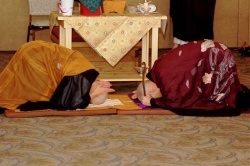
In the White Plum Asanga, Dharma transmission comes first, and qualifies one as a sensei. This may be followed by inka, the final acknowledgemment:
- … once you have transmission then your teacher is sort of watching to see how you’re doing as a teacher – on how you are conducting yourself and, after a period of time, if the teacher has confidence in your understanding and ability to teach (that you are conducting yourself with integrity and clarity) then, at some point, the person will get the final seal of approval – which is what inka is. There is nothing particularly mysterious about it.
Korean Soen
In Korean Soen, Inka (In'ga) typically refers to the private acknowledgement of dharma transmission from a teacher to their student. "Transmission" is used to refer to the public ceremonial version of the same acknowledgement.
Both are considered equal in authority and "realization". A monk with either In'ga or the public "transmission" is qualified to hold the post of Soen Sa, or "Zen Master" for a temple, and give transmission to their own students (either, In'ga or public "transmission"). The majority of Zen Masters in Korea have only received, and only give In'ga, with the formal transmission ceremony being far more rare.
In the Western Kwan Um School of Zen created by the Korean monk Seung Sahn (who himself only ever received the private acknowledgement of In'ga ), "Inka" is granted to an individual who has completed their koan training and is granted the title Ji Do Poep Sa Nim. Dharma transmission in the Kwan Um School of Zen comes after inka, denoting the individual is now a Soen Sa Nim. Seung Sahn himself is quoted saying in reference to the administration of his Western organization,
- Inka and transmission are different. Our 'Ji Do Poep Sa Nim' title is like the Japanese title 'sensei.' In Korea, we call it 'Chong Yong Sun'—your practice is okay, teaching other people is possible. This title has almost disappeared in Korea, although it still exists in China. In Korea we now have the title 'Ip Sung Sunim.'—'head monk.'" This innovation applies only to Seung Sahn's Western organization, and is not normative for Korean Soen/Zen practice either historically, or currently.
Vietnamese Thien
Thich Nhat Hanh has created a ritual known as "Lamp Transmission", making a teacher a Dharmacharya—an individual with "limited teaching authority." According to author James Ishmael Ford,
- Regarding the issue of Dharma transmission, Thich Nhat Hanh has said no single student will succeed him. Instead his community of practice will itself be his successor. He is quoted as saying Maitreya, the Buddha of future birth, may be a community of practice rather than an individual. What this actually means will only become apparent over the next decades.
1-Bodhidharma. 2-Huike. 3-Sengcan. 4-Daoxin. 5-Hongren. 6-Huineng. 7-Nanyue Huairang. 8-Mazu Daoyi. 9-Baizhang Huaihai. 10-Huangbo Xiyun. 11-Linji Yixuan. 43-Nguyen Thieu. 44-Tu Dung. 45-Lieu Quan. 46-Luu Quang. 47-Chieu Nhien. 48-Pho Tinh. 49-Nhat Dinh. 50-Cuong Ky. 51-Thich Tue Minh. 51-Thich Chan That. 52-Thich Nhat Hanh.
Criticism
In the western understanding, dharma transmission stands solely for recognition of authentic insight, whereas in the Japanese monastery system dharma transmission is a formal notification that someone is fully qualified to take a leading role in this system. In the USA and Europe dharma transmission is linked to the unofficial title roshi, older teacher. In the Western world roshis have been given an archetypal status as wise old man, someone who has realized an infallible insight into the true self, and a perfect personality. In daily life this appears to be an idealized view, given the repeated cases of abuse of power, and financial and sexual misbehavior.

